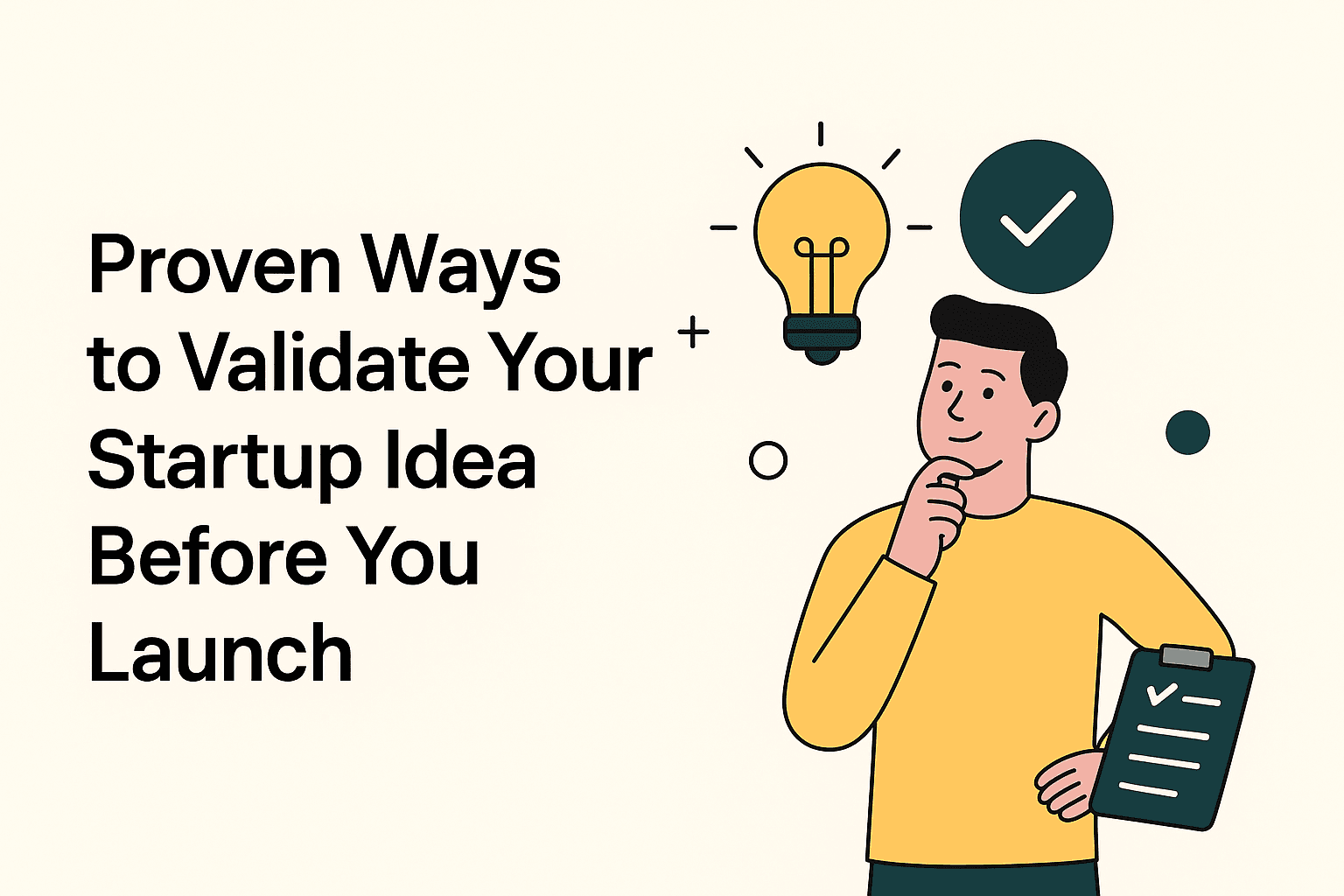Discover proven ways to validate your startup idea before launch. Avoid failure, save money, and build products people truly want.
Launching a startup is exciting but it's also risky. Statistics show that 90% of startups fail, and one of the top reasons is building something no one wants.
If you're working on a new idea, you might wonder: How do I know if people will actually pay for this?
The answer is validation. Validating your startup idea before you launch helps you confirm market demand, refine your solution, and save time and money.
In this guide, we'll cover proven ways to validate your startup idea step by step, so you can launch with confidence.
Why Startup Validation Matters
Before we dive into strategies, let's understand why validation is crucial:
- Reduces risk: You avoid wasting resources on ideas that don't work.
- Confirms demand: You'll know if people want your solution.
- Attracts investors: Validated ideas are more appealing to investors and partners.
- Refines your product: Real feedback helps you improve before scaling.
In short, validation increases your chances of joining the 10% of startups that succeed.
1. Talk to Potential Customers Directly
The simplest way to validate your idea is to talk to your target audience.
- Create a list of 20–50 people who match your ideal customer profile.
- Reach out via LinkedIn, Twitter (X), communities, or even in person.
- Ask open-ended questions like:
- What's the biggest problem you face with [your niche]?
- How are you currently solving this problem?
- Would you pay for a better solution?
💡 Pro tip: Avoid asking "Would you use my idea?" People often say yes just to be polite. Instead, ask about current pain points and spending habits.
2. Build a Minimum Viable Product (MVP)
An MVP is a simplified version of your product that demonstrates the core value without all the bells and whistles.
Examples:
- Instead of building a full app, create a landing page with your product concept.
- Instead of coding, make a demo video or clickable prototype using tools like Figma.
- Instead of offering 10 features, launch with just one core feature.
If people use your MVP, sign up, or even pay, you've got real validation.
3. Run a Smoke Test
A smoke test lets you measure demand before the product exists.
How?
- Build a simple landing page explaining your solution.
- Add a "Sign Up" or "Pre-order Now" button.
- Run Google Ads or social media ads to drive traffic.
- Track conversion rates.
👉 If people click and provide their email (or payment details), you've validated real market demand.
4. Leverage No-Code Tools to Test Quickly
You don't need to hire developers to test your idea. Use no-code tools like:
- Carrd, Webflow, or Wix → Build landing pages.
- Bubble or Glide → Create app prototypes.
- Zapier & Airtable → Automate backend workflows.
This lets you test ideas in days instead of months, with minimal cost.
5. Validate With Pre-Sales
One of the strongest validation signals is when people pay you before you build.
Here's how to do it:
- Offer early bird pricing or lifetime deals.
- Use platforms like Gumroad, LemonSqueezy, or Stripe to accept pre-orders.
- Clearly explain when the product will be delivered.
💡 If you can collect even 5–10 paid pre-orders, you know you're onto something valuable.
6. Research Competitors and Market Trends
Don't fear competition—it's actually a good sign. If others are solving the same problem, it means there's demand in the market.
Steps:
- Search for similar tools on Google, Product Hunt, or What Launched Today.
- Study reviews on G2, Capterra, or Trustpilot to learn what customers love or hate.
- Check Google Trends and keyword tools to see search demand.
👉 Your goal isn't to reinvent the wheel—it's to offer a better, faster, or cheaper solution.
7. Use Social Media Validation
Social media is a goldmine for quick validation.
- Post your idea on Reddit, Indie Hackers, or Twitter (X).
- Share mockups and ask for feedback.
- Run polls and measure engagement.
If people like, comment, share, or DM you asking "When will this launch?" that's a clear sign of interest.
8. Crowdfunding Campaigns
Platforms like Kickstarter and Indiegogo let you validate and raise money simultaneously.
- Share your product story, prototype, and benefits.
- Set a funding goal.
- If people back your campaign, you have proof that your idea has market demand.
9. Collect and Measure Feedback
Validation isn't just about asking—it's about measuring actions.
Key metrics to track:
- Landing page conversion rate (above 10% is strong).
- Email sign-ups (more sign-ups = higher interest).
- Willingness to pay (the strongest signal of all).
10. Iterate Before You Launch
Validation is not a one-time task. It's a continuous process.
- If you get positive signals → move forward.
- If you get mixed feedback → refine your idea.
- If you get no interest → pivot before wasting more time.
Common Mistakes in Startup Validation
- Asking only friends and family (they'll be biased).
- Ignoring negative feedback.
- Falling in love with your solution instead of the problem.
- Skipping validation entirely and just building.
Avoid these traps, and you'll save months of wasted effort.
Final Thoughts
Validating your startup idea doesn't guarantee success—but it massively improves your odds.
By talking to customers, testing with MVPs, running ads, and securing pre-sales, you can confidently determine whether your idea is worth pursuing.
Instead of guessing, let the market decide.

